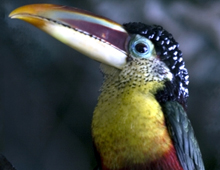Description: The most interesting characteristic of the Curl-crested aracari is the shiny, black curled feathers on its head that look like pieces of plastic or curled ribbon. The bare skin around the eyes is blue; the whitish-yellow facial feathers have hardened black tips; the patterned, multicolored bill has an orange tip; the back is red; the breast is yellow with red blotches and a single red band. The tail is long, varying in color but has a greenish- bronze dominant color. This species is often considered to be the most attractive and colorful of the smaller toucans. The bill of the female is shorter than the male’s.
Size: This aracari reaches lengths of 16-18 inches (41 – 46 cm).
Behavior: The Curl-crested aracari is a social bird. It will sleep with up to five adults and their fledged offspring in the same nesting hole.
Diet: The diet consists mainly of fruit, however, it will also consume eggs and nestlings. They forage in groups, often up to a dozen individuals.
Communication: This species makes sounds, with much variability – fast to slow, deep to soft and grunt-like vocalizations.
Reproduction: Nests are in abandoned tree hollows, usually made by woodpeckers. Three to four white, elliptical-shaped eggs are laid. Incubation is about 16 days and both parents share these duties. When born, the chicks are blind and naked. They fledge after six weeks.
Habitat/range: The Curl-crested aracari inhabits tropical moist lowland forests of western Amazonia in southern Peru (south of the Amazon), western Brazil and northern Bolivia.
Status: Listed as Least Concern on IUCN Red List.



